110218 Protocole starter packs - Cisbio Bioassays
110218 Protocole starter packs - Cisbio Bioassays
110218 Protocole starter packs - Cisbio Bioassays
Create successful ePaper yourself
Turn your PDF publications into a flip-book with our unique Google optimized e-Paper software.
Headquarters & Europe Office<br />
<strong>Cisbio</strong> <strong>Bioassays</strong><br />
Phone: +33 (0)4 66 79 67 05<br />
Fax: +33 (0)4 66 79 19 20<br />
bioassays@cisbio.com<br />
USA Office<br />
<strong>Cisbio</strong> US, Inc.<br />
Phone : +1 888 963 4567<br />
Fax : +1 781 687 1500<br />
htrfinfo@cisbio.us<br />
China Office<br />
IBA China<br />
Phone : +86 10 8080 9288<br />
Phone : +86 10 8080 9299<br />
htrfinfo@iba-group.com<br />
Japan Office<br />
Sceti Medical Labo K.K.<br />
Phone: +81 (0)3 5510 2932<br />
Fax: +81 (0)3 5510 0130<br />
reagent@scetimedilabo.co.jp<br />
Recommended protocol for<br />
Tag-lite C5A (1 Million labeled cells) C1TT1C5A Batch 001<br />
For in vitro research use only<br />
Storage temperature: -80°C<br />
Anaphylatoxin C5a receptor ligand binding assays<br />
This protocol is optimised for 384 wells Small Volume white (Greiner #784075) and<br />
allows to perform a minimum of 200 tests.<br />
Cells must be stored at -80°C until thawing.<br />
The thawing must be as rapid as possible.<br />
This assay is based on the competition between the Tag-lite fluorescent ligand<br />
and compound.<br />
Assay description<br />
Storage and<br />
handling<br />
The entire kit has to be stored at -80°C. When you wish to start this protocol, be<br />
sure to keep the cells at -80°C, then thaw once all the other reagents are ready.<br />
Required<br />
reagents<br />
Description Part #<br />
Tag-lite buffer 5x 100ml<br />
LABMED<br />
Anaphylatoxin receptors red agonist 5,000 tests<br />
L0042RED<br />
Tag-lite ready-to-use cells (transformed & labeled)<br />
Tag-lite C5A (1 Million labeled cells)<br />
C1TT1C5A
A - Tag-lite buffer (1x) preparation (TLB)<br />
Thaw the 100ml vial of Tag-lite buffer (TLB 5x). Dilute 1:5 Tag-lite<br />
buffer (5x) into distilled water to obtain TLB (1x).<br />
Required volume of TBL(1x) depends on the number of compounds you<br />
want to test. To simplify the preparation of future assays, you should freeze<br />
the rest of Tag-lite buffer(5x) in different aliquots.<br />
B - Ligand preparation<br />
Prepare the working solution F1 (40nM) by dilution of the fluorescent<br />
ligand Anaphylatoxin receptors red agonist (see concentration on<br />
package insert) into TLB (1x).<br />
F1 required volume depends on the number of compounds you want to test.<br />
To simplify the preparation of future assays, you should freeze the rest of<br />
Tag-lite ligand stock solution in different aliquots.<br />
a) Kd determination<br />
Prepare ten further 1:2 serial dilutions starting from F1 with TLB (1x)<br />
diluting 100µL with 100 µl of TLB (1X) each time.<br />
Fstock<br />
(See package insert)<br />
F1 (40nM)<br />
Fluorescent ligand concentration (nM)<br />
Working solution Final concentration<br />
F1 40 10<br />
F2 20 5<br />
F3 10 2.5<br />
F4 5 1.25<br />
F5 2.5 0.63<br />
F6 1.25 0.32<br />
F7 0.63 0.16<br />
F8 0.32 0.08<br />
F9 0.16 0.04<br />
F10 0.08 0.02<br />
F11 0.04 0.01<br />
Add 100µl of TLB (1X) from F2 to F11<br />
+<br />
100µl 100µl 100µl 100µl 100µl 100µl 100µl 100µl 100µl 100µl<br />
b) Competition assays<br />
Follow the instructions below to carry out binding competition assays. If you need a specific, optimized<br />
protocol for your compounds, please contact our service team.<br />
The non specific binding (NSB) signal is determined using a large excess of unlabelled ligand (reagent not<br />
provided, we recommend using W-54011). This solution will be named REF1.<br />
The optimal Anaphylatoxin receptors red agonist concentration in wells is 1 nM.<br />
1.Dilute the F1(40nM) solution into TLB (1x) to prepare a working<br />
solution called FC (Fluorescent solution for Competition) (4nM).<br />
FC required volume depends on the number of compounds you want to test.<br />
2.From a reference ligand solution of your choice called REF1 at<br />
4.10 -4 M, do ten 1:10 serial dilutions with TLB (1x) by diluting 10 µL<br />
into 90 µl of TLB (1x).<br />
This reference ligand concentration range is used as an inter-assay control.<br />
F1 (40nM)<br />
FC (4 nM)
Reference ligand concentration (M)<br />
working solutions Final concentration<br />
REF1 4.10 -4 10 -4<br />
REF2 4.10 -5 10 -5<br />
REF3 4.10 -6 10 -6<br />
REF4 4.10 -7 10 -7<br />
REF5 4.10 -8 10 -8<br />
REF6 4.10 -9 10 -9<br />
REF7 4.10 -10 10 -10<br />
REF8 4.10 -11 10 -11<br />
REF9 4.10 -12 10 -12<br />
REF10 4.10 -13 10 -13<br />
REF11 4.10 -14 10 -14<br />
3. Prepare a concentration range of your compounds. We recommend treating them the same way<br />
as the reference ligand.<br />
Example for compound X:<br />
Compound X concentration (M)<br />
working solutions Final concentration<br />
X1 4.10 -4 10 -4<br />
X2 4.10 -5 10 -5<br />
X3 4.10 -6 10 -6<br />
X4 4.10 -7 10 -7<br />
X5 4.10 -8 10 -8<br />
X6 4.10 -9 10 -9<br />
X7 4.10 -10 10 -10<br />
X8 4.10 -11 10 -11<br />
X9 4.10 -12 10 -12<br />
X10 4.10 -13 10 -13<br />
X11 4.10 -14 10 -14<br />
C - Cell preparation<br />
1. Prepare a conical vial (A) containing 5 mL of TLB (1x)<br />
2.Thaw labelled frozen cells at 37°C (water bath, m anual shaking)<br />
until all the ice is thawed (1-2min) and transfer them quickly by<br />
pipeting into the vial prepared above.<br />
3. Centrifuge 5 min at 1200 G at 4°C (1500 rpm).<br />
4.Gently remove supernatant by aspiration.<br />
5. Re-suspend the pellet in 2.7 ml of TLB (1x), mix gently by<br />
aspiration.<br />
Resuspend in 2.7 ml of TLB (1x)
D - Dispensing following the plate plan<br />
Distribution<br />
Total signal<br />
wells<br />
Non-specific<br />
signal wells<br />
Reference Ki<br />
determination wells<br />
EC50 determination<br />
wells<br />
1 st 10µl of cell preparation<br />
2nd 5µl of TLB (1x) 5µl of REF1<br />
5µl of REF11 to REF1<br />
and<br />
5µl of TLB (1x)<br />
5µl of X11 to X1<br />
and<br />
5µl of TLB (1x)<br />
3rd 5µl of F11 to F1 and 5µl of TLB (1x) 5µl of FC<br />
E - Reading and data reduction<br />
1. Read the plate on an HTRF ® compatible reader (at 665nm and 620 nm) after 3h incubation.<br />
2. Data reduction<br />
665/620 Ratio =<br />
Fluorescence Intensity at 665nm<br />
Fluorescence Intensity at 620nm<br />
X 10 4<br />
Example of data obtained for Anaphylatoxin C5a receptor with W-54011 as reference ligand<br />
Ratio 665/620<br />
Ratio 665 / 620<br />
Kd= 0.8 +/- 0.7 nM<br />
Ratio 665/620<br />
Ratio 665 / 620<br />
Ki = 40 +/- 37 nM<br />
[L-RED] finale<br />
[Compound]<br />
This product contains material of biologic origin. Use for research purposes only. Do not use in humans or for diagnostic purposes. The<br />
purchaser assumes all risk and responsibility concerning reception, handling and storage. The use of the cell line will be done with<br />
appropriate safety and handling precautions to minimize health and environmental impact. The product is genetically modified and must<br />
be used according to biosafety level S1.The Tag-lite® C5a cells are derived from a HEK 293 background genetically modified to<br />
transiently express the Human C5a . As a condition of sale, use of this product must be in accordance with all applicable local legislation<br />
and guidelines including EC Directive 01/18/EC on the contained use of genetically modified organisms<br />
Copyright © 2011<strong>Cisbio</strong> <strong>Bioassays</strong>, France<br />
SNAP-tag and CLIP-tag are trademarks exclusively licensed to New England Biolabs. Plasmids encoding SNAP-tag and CLIP-tag and their substrates are made under license from<br />
New England Biolabs and may be covered by one or more of the following published patent applications filed internationally in US, EP and JP and also in additional jurisdictions :<br />
WO2002/083937 WO2004/031405 WO2004/104588 WO2004/031404 WO2005/085470 WO2008/012296 US, WO2008/122604 and EP patents 1410023 and 1696234.<br />
Lumi4 is a registered trademark of Lumiphore, Inc. Lumi4-based products may be covered under one or more U.S. patents: 6,515,113, 6,864,103, 7,442,558, 6,406,297,7,018,850, and<br />
7,404,912 or international equivalents.


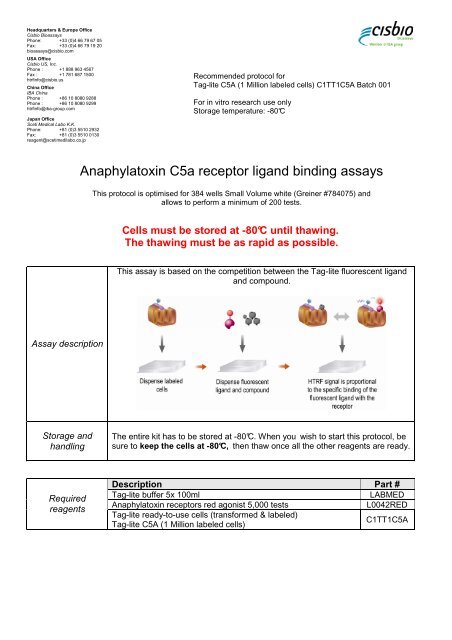
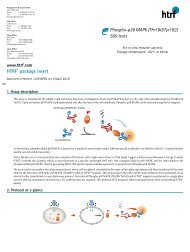

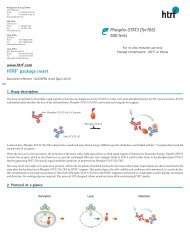
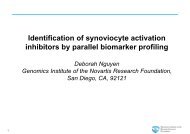
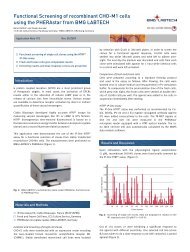
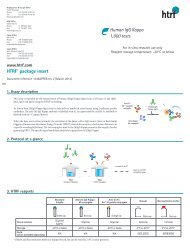
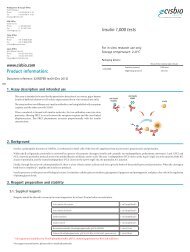
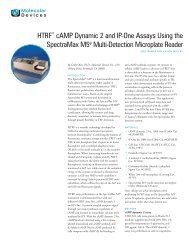
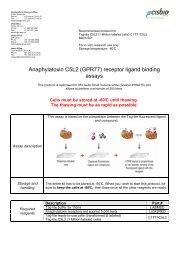
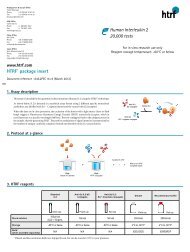
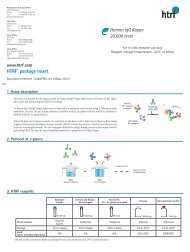
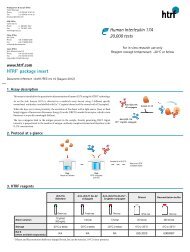

![HTRF meeting_130426_villa_pour pdf [Mode de compatibilité]](https://img.yumpu.com/22345646/1/190x135/htrf-meeting-130426-villa-pour-pdf-mode-de-compatibilitac.jpg?quality=85)